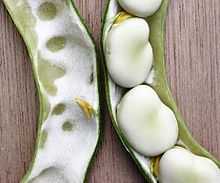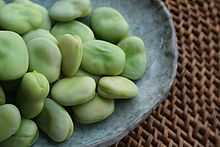Maccu


Maccu, (also known as maccu di fave,[1][2] and sometimes referred to as macco[3]), is a Sicilian soup and also a foodstuff that is prepared with dried and crushed fava beans (also known as broad beans) and fennel as primary ingredients.[4][5] It dates back to ancient history. The dish is now rare to in Sicily, but it occasionally appears on restaurant menus there. Several dishes exist using maccu as a foodstuff, such as Bruschetta al maccú and Maccu di San Giuseppe, the latter of which may be served on Saint Joseph's Day in Sicily.
History
Maccu is a peasant food[2] and staple food that dates back to ancient history.[4][6][7] The Roman people may have invented or introduced the foodstuff, which was created from crushed fava beans.[1][7] The food was also "known from the Greek period".[1]
Ingredients and preparation
Primary ingredients include fava beans, fennel seeds and sprigs, olive oil, salt and pepper.[4] Additional ingredients may include tomato, onion and pasta.[4] The soup is sometimes cooled until it solidifies, then cut into strips, breaded in flour and fried in olive oil.[4] Some preparations of maccu may use fava beans that have been puréed.[8]
In contemporary times
Although maccu's availability in contemporary times in Sicily is generally rare,[7] it is still occasionally served in restaurants there.[4]
Dishes that use maccu
Bruschetta al maccú is a simple dish prepared with bruschetta and maccu that may be served as an appetizer or lunch dish.[6]
Maccu di San Giuseppe (English: maccu of St. Joseph) is a traditional Sicilian dish that consists of various ingredients and maccu.[9] The dish may be prepared on Saint Joseph's Day in Sicily, to clear out pantries and allow room for the spring's new crops of vegetables.[9] In Sicily, St. Joseph is regarded by many as their patron saint, and in many Italian-American communities, thanks are given to St. Joseph ("San Giuseppe" in Italian) for preventing a famine in Sicily during the Middle Ages. According to legend, there was a severe drought at the time, and the people prayed for their patron saint to bring them rain. They promised that if he answered their prayers, they would prepare a large feast to honor him. The rain did come, and the people of Sicily prepared a large banquet for their patron saint. The fava bean was the crop which saved the population from starvation and is a traditional part of St. Joseph's Day altars and traditions. Giving food to the needy is a St. Joseph's Day custom.
Rigatoncini con maccu di fave is a Sicilian dish prepared with rigatoncini pasta (a smaller version of rigatoni) and fava bean paste.[10]
See also
References
- ↑ 1.0 1.1 1.2 Rallo, John A. The Sicilian Triangle. Xlibris Corporation. p. 177. ISBN 1465326669.
- ↑ 2.0 2.1 Riley, Gillian (2007). The Oxford Companion to Italian Food. Oxford University Press. p. 501. ISBN 0198606176.
- ↑ Sinclair, Charles Gordon (1998). International Dictionary of Food and Cooking. Taylor & Francis. p. 329. ISBN 1579580572.
- ↑ 4.0 4.1 4.2 4.3 4.4 4.5 Helstosky, Carol (2009). Food Culture in the Mediterranean. Greenwood Publishing Group. p. 7. ISBN 0313346267.
- ↑ Facaros, Dana; Pauls, Michael (2008). Sicily. New Holland Publishers. p. 53. ISBN 1860113974.
- ↑ 6.0 6.1 La Place, Viana; Kleiman, Evan (2011). Cucina Rustica. Harper Collins. pp. 44–45. ISBN 0060935111.
- ↑ 7.0 7.1 7.2 Simeti, Mary Taylor (1989). Pomp and sustenance: twenty-five centuries of Sicilian food. Knopf. pp. 9–10.
- ↑ Touring Club of Italy, Touring Club Italiano (2002). The Italian Food Guide. Touring Editore. p. 581. ISBN 8836525385.
- ↑ 9.0 9.1 Clarkson, Janet (2013). Food History Almanac. Rowman & Littlefield. p. 262. ISBN 144222715X.
- ↑ DiDio, Tony; Zavatto, Amy (2003). The Renaissance Guide to Wine and Food Pairing. Penguin. p. 218. ISBN 1440650985.